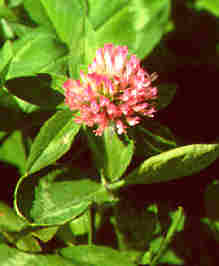
Plant Description
Caution & Interaction

Latin (botanical) name:
Trifolium pratense
Common names: Red Clover, Trefoil, Purple Clover, Meadow Honeysuckle, Meadow Trefoil, Purple Clover, Trefoil, Wild Clover, Cleaver Grass, Marl Grass, Cow Grass
Plant Description: The state flower of Vermont, Red Clover is also abundant in Britain, throughout Europe, Central and Northern Asia from the Mediterranean to the Arctic Circle and high up into the mountains. It generally grows wild in meadows, blooming in April and throughout the summer months. It has several somewhat hairy stems 1-2 feet high growing from one root. The root is rhizome and sends out runners. The leaves of the Red Clover are ternate with ovate leaflets finely serrate and very pointed. The flowers themselves vary from deep red to purple and are ovoid in shape.
Medicinal Properties &Uses: Red Clover contains small amounts of silica, choline, calcium and lecithin. It is an effective treatment for many skin conditions such as acne, scaly or dry skin, psoriasis and eczema. It can be applied to cancerous growths, as well. Ingested internally, Red Clover helps calm nervousness and alleviate symptoms of stress. It works also as a muscle relaxer, and has proven to be a good expectorant. As Red Clover contains phytoestrogens, hormone-like substances, it is effective in treating symptoms of menopause such as hot flashes and vaginal dryness. Double-blind studies conducted recently found no difference between Red Clover and a placebo in the treatment of menopausal symptoms. The studies tested daily doses of 40mg or 60mg of Red Clover administered for 12 weeks.
Dosage: 30-60 drops in water or juice, 2-3 times daily or as needed.
Cautions & Interactions: Do not take during pregnancy. Keep out of reach of children.
Efficacy Studies & Other Clinical Data: Helpful Links:
Disclaimer (U.S. Only): These statements have not been evaluated by the FDA. These products are not intended to diagnose, cure, treat, or prevent any disease.
Common names: Red Clover, Trefoil, Purple Clover, Meadow Honeysuckle, Meadow Trefoil, Purple Clover, Trefoil, Wild Clover, Cleaver Grass, Marl Grass, Cow Grass
Plant Description: The state flower of Vermont, Red Clover is also abundant in Britain, throughout Europe, Central and Northern Asia from the Mediterranean to the Arctic Circle and high up into the mountains. It generally grows wild in meadows, blooming in April and throughout the summer months. It has several somewhat hairy stems 1-2 feet high growing from one root. The root is rhizome and sends out runners. The leaves of the Red Clover are ternate with ovate leaflets finely serrate and very pointed. The flowers themselves vary from deep red to purple and are ovoid in shape.
Medicinal Properties &Uses: Red Clover contains small amounts of silica, choline, calcium and lecithin. It is an effective treatment for many skin conditions such as acne, scaly or dry skin, psoriasis and eczema. It can be applied to cancerous growths, as well. Ingested internally, Red Clover helps calm nervousness and alleviate symptoms of stress. It works also as a muscle relaxer, and has proven to be a good expectorant. As Red Clover contains phytoestrogens, hormone-like substances, it is effective in treating symptoms of menopause such as hot flashes and vaginal dryness. Double-blind studies conducted recently found no difference between Red Clover and a placebo in the treatment of menopausal symptoms. The studies tested daily doses of 40mg or 60mg of Red Clover administered for 12 weeks.
Dosage: 30-60 drops in water or juice, 2-3 times daily or as needed.
Cautions & Interactions: Do not take during pregnancy. Keep out of reach of children.
Efficacy Studies & Other Clinical Data: Helpful Links:
Disclaimer (U.S. Only): These statements have not been evaluated by the FDA. These products are not intended to diagnose, cure, treat, or prevent any disease.